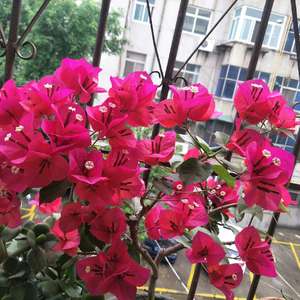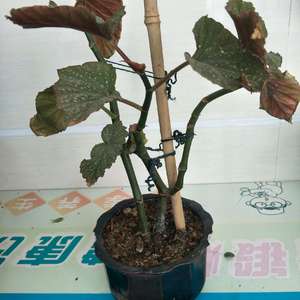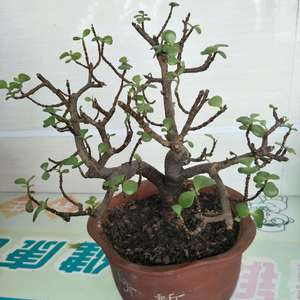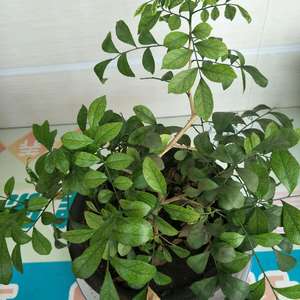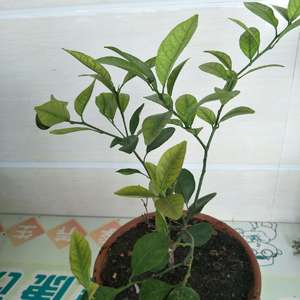文章
Miss Chen
2018年06月26日

Description: This herbaceous perennial wildflower is 3-5' tall. The erect stems are unbranched, except in the upper-third of each plant. Each stem is light green, glabrous, 4-angled, and slightly winged on the angles. The opposite leaves are up to 4" long and 1½" across; they are lanceolate, lanceolate-ovate, or ovate, smooth along the their margins, and glabrous. The upper surface of each leaf is medium green, while the lower surface is pale green. The leaves are sessile or they clasp the stem slightly.
The central stem and lateral upper stems (if any) terminate in cymes of 1-5 flowers. Relative to the size of the flowers, branches of each cyme are rather short. Each flower is about 2" across, consisting of 5 yellow petals, 5 green sepals, numerous yellow stamens (about 100), and a light green pistil with 5 persistent styles. The petals are widely spreading and often rather floppy or contorted; they may develop streaks of white with age. The sepals are lanceolate-ovate and much shorter than the petals. The blooming period occurs during mid-summer and lasts about 2-3 weeks. Each flower is replaced by a large hairless seed capsule up to 1¼" long and ½" across. Each seed capsule is divided into 5 cells; each cell containsDistribution Map numerous small seeds that are narrowly oblongoid, flattened, and black at maturity. The root system is rhizomatous, often forming small colonies of plants.
Cultivation: The preference is full sun to light shade and moist conditions. This wildflower adapts to different kinds of soil, including loam, clay-loam, and rocky soil. It is robust and easy to grow.
Range & Habitat: The native Giant St. John's Wort is occasional in northern and west-central Illinois; it is rare or absent elsewhere in the state. Illinois lies along the southern range limit of this species in North America; it also occurs in Eurasia. Habitats are rather variable, but they include woodland openings, wooded slopes, banks of rivers and streams, moist thickets and meadows, river-bottom prairies, and fens. This species is usually found in high quality habitats. It is sometimes cultivated in gardens.
Faunal Associations: The flowers are pollinated primarily by bumblebees, which collect pollen. Smaller bees and other insects may visit the flowers as well, but they are less effective pollinators. Only pollen is available as a reward to floral visitors. Some insects feed on the leaves, flowers, and other parts of this and other Hypericum spp. (St. John's Wort species). These include the caterpillars of the moths Eupithecia miserulata (Common Pug), Melanchra assimilis (Black Arches), Synchlora aerata (Wavy-Lined Emerald), Hyppa xylinodes (Common Hyppa), Nedra ramosula (Gray Half-Spot), and Agonopterix hyperella (Oecophorid Moth sp.). The caterpillars of the butterfly Strymon melinus (Gray Hairstreak) feed on the developing capsules and seeds. Other insects that feed on Hypericum spp. include the aphid Brachysiphum hyperici, and the leaf beetles Pachybrachis relictus and Paria sellata. The foliage is somewhat toxic to mammalian herbivores and usually avoided because it can cause irritation of the gastrointestinal tract. The foliage can also cause a harmful reaction to sunlight in light-skinned animals (e.g., pigs), causing irritation of the skin.
Photographic Location: A restored prairie at Meadowbrook Park in Urbana, Illinois.
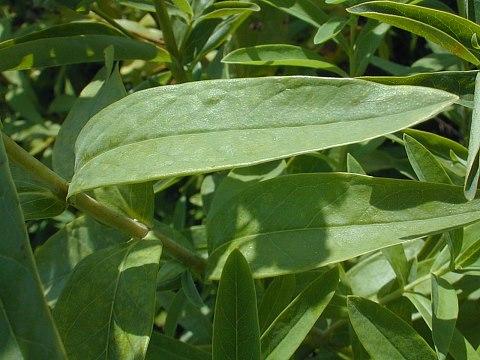
Comments: This species has large attractive flowers and foliage. Unfortunately, the blooming period is relatively short. Giant St. John's Wort is easy to identify because of its large size and the presence of 5 styles on its flowers and seed capsules. Other large Hypericum spp. are usually woody, rather than herbaceous, and they usually have only 1-3 styles. An exception is the woody Hypericum kalmianum (Kalm's St. John's Wort), which also has 5 styles. This latter species has smaller flowers, more narrow leaves, and a shorter and more branched habit of growth than Giant St. John's Wort. Some taxonomists consider North American populations of Giant St. John's Wort to be distinct from the Eurasian populations, and refer to this species as Hypericum pyramidatum. Another common name of this species is Great St. John's Wort.
The central stem and lateral upper stems (if any) terminate in cymes of 1-5 flowers. Relative to the size of the flowers, branches of each cyme are rather short. Each flower is about 2" across, consisting of 5 yellow petals, 5 green sepals, numerous yellow stamens (about 100), and a light green pistil with 5 persistent styles. The petals are widely spreading and often rather floppy or contorted; they may develop streaks of white with age. The sepals are lanceolate-ovate and much shorter than the petals. The blooming period occurs during mid-summer and lasts about 2-3 weeks. Each flower is replaced by a large hairless seed capsule up to 1¼" long and ½" across. Each seed capsule is divided into 5 cells; each cell containsDistribution Map numerous small seeds that are narrowly oblongoid, flattened, and black at maturity. The root system is rhizomatous, often forming small colonies of plants.
Cultivation: The preference is full sun to light shade and moist conditions. This wildflower adapts to different kinds of soil, including loam, clay-loam, and rocky soil. It is robust and easy to grow.
Range & Habitat: The native Giant St. John's Wort is occasional in northern and west-central Illinois; it is rare or absent elsewhere in the state. Illinois lies along the southern range limit of this species in North America; it also occurs in Eurasia. Habitats are rather variable, but they include woodland openings, wooded slopes, banks of rivers and streams, moist thickets and meadows, river-bottom prairies, and fens. This species is usually found in high quality habitats. It is sometimes cultivated in gardens.
Faunal Associations: The flowers are pollinated primarily by bumblebees, which collect pollen. Smaller bees and other insects may visit the flowers as well, but they are less effective pollinators. Only pollen is available as a reward to floral visitors. Some insects feed on the leaves, flowers, and other parts of this and other Hypericum spp. (St. John's Wort species). These include the caterpillars of the moths Eupithecia miserulata (Common Pug), Melanchra assimilis (Black Arches), Synchlora aerata (Wavy-Lined Emerald), Hyppa xylinodes (Common Hyppa), Nedra ramosula (Gray Half-Spot), and Agonopterix hyperella (Oecophorid Moth sp.). The caterpillars of the butterfly Strymon melinus (Gray Hairstreak) feed on the developing capsules and seeds. Other insects that feed on Hypericum spp. include the aphid Brachysiphum hyperici, and the leaf beetles Pachybrachis relictus and Paria sellata. The foliage is somewhat toxic to mammalian herbivores and usually avoided because it can cause irritation of the gastrointestinal tract. The foliage can also cause a harmful reaction to sunlight in light-skinned animals (e.g., pigs), causing irritation of the skin.
Photographic Location: A restored prairie at Meadowbrook Park in Urbana, Illinois.

Comments: This species has large attractive flowers and foliage. Unfortunately, the blooming period is relatively short. Giant St. John's Wort is easy to identify because of its large size and the presence of 5 styles on its flowers and seed capsules. Other large Hypericum spp. are usually woody, rather than herbaceous, and they usually have only 1-3 styles. An exception is the woody Hypericum kalmianum (Kalm's St. John's Wort), which also has 5 styles. This latter species has smaller flowers, more narrow leaves, and a shorter and more branched habit of growth than Giant St. John's Wort. Some taxonomists consider North American populations of Giant St. John's Wort to be distinct from the Eurasian populations, and refer to this species as Hypericum pyramidatum. Another common name of this species is Great St. John's Wort.
0
0
成长记
2B_BotanicalFie
2018年06月24日

Unfortunately a lot of gnats.... eventough seller denied After 4 weeks of quarantine, using all kind of methods against gnats... I had to throw it away since the plague just kept continuing and it made me crazy and i didnt want my other plants effected




0
0
文章
Miss Chen
2018年06月24日

Description: This herbaceous perennial plant has branching leafy stems that are 4–16" long. These stems have a tendency to sprawl and cling to adjacent vegetation; they are light green to light greenish purple, and 4-angled. The stems have short stiff hairs along their angles, otherwise they are hairless. Whorls of 4 spreading leaves (never 5–6 leaves) occur at intervals along these stems; these leaves are sessile, or nearly so. Individual leaves are 6-19 mm. (¼–¾") long, narrowly elliptic or narrowly elliptic-oblanceolate in shape, and toothless along their margins. The leaf tips are rounded. The leaf surfaces are yellowish green to medium green; short stiff hairs occur along the margins of the leaves and along the underside of their central veins. The short stiff hairs of both the stems and leaves can cling to neighboring vegetation or objects. Each leaf has a prominent central vein. The stems often terminate in small clusters of 2-3 flowers; either solitary or small clusters of 2-3 flowers are also produced from the axils of leaves.
Each flower is about 1.5–2 mm. across, consisting of a white corolla with 3 lobes, 3 stamens, 2 styles that are joined together at the base, and 2 spheroid light green ovaries that are connected together. The lobes of the corolla are oval-ovate in shape. The pedicels of the flowers are usually longer than the corresponding leaves. These pedicels are light green to light purplish green and usually more or less curved; they have short stiff hairs that can cling to adjacent vegetation or objects. The pedicels become even longer as the ovaries mature. The blooming period occurs from mid-summer to late summer for about 1½ months. Only a few flowers are in bloom at the same time. Afterwards, the maturing paired ovaries expand in size, changing color from light green (or light purple) to brown (or black) at maturity. These ovaries are hairless and single-seeded; they eventually split apart. The small seeds are spheroid in shape and partially hollow inside; they are capable of floating on water and being distributed by it. The root system is shallow and fibrous.
Cultivation: The preference is full or partial sun, shallow water or wet conditions, a substrate containing some sand or organic material, and a relatively cool climate.

Range & Habitat: Small Bedstraw (Galium trifidum) is uncommon in Illinois, occurring in the NE section of the state, and a central section of the state along or near the Illinois River (see Distribution Map). Illinois lies along the southern range-limit of this species. It is more widely distributed in North America further to the north and it also occurs in Eurasia. Habitats include edges of sphagnum bogs, cattail marshes, low sandy areas along rivers, and northern swamps. In Illinois, Small Bedstraw is found in high quality wetlands in natural areas.
Faunal Associations: Various insects feed on foliage or sap of bedstraws (Galium spp.). These insect feeders include the larvae of a leaf-mining fly (Galiomyza galiivora), larvae of the Bedstraw Midge (Dasineura americana), larvae of an introduced sawfly (Halidamia affinis), and larvae of the Galium Sphinx (Hyles gallii); see Spencer & Steyskal, 1986; Felt, 1917; Smith, 2006; Wagner, 2005). Other insects that have been observed to feed on bedstraws include aphids, the larvae of Geometer moths, plant bugs (Miridae), stinkbugs (Pentatomidae), and ebony bugs (Thyreocoridae). The nectar and pollen of the flowers of these plants attract primarily small bees and flies (Robertson, 1929). Bedstraws that inhabit wetlands are a minor source of food to Muskrats (Hamerstrom & Blake, 1939).

Photographic Location: A cattail marsh near Volo Bog in Lake County, Illinois.
Comments: This bedstraw is quite small in size and rather inconspicuous. It can be distinguished from other bedstraw species (Galium spp.) primarily by the 3-lobed corollas of its flowers, the whorls of 4 leaves along its stems, the long curved pedicels of its flowers or fruits, and its strong preference for wetland habitats. The only other bedstraw species that produces 3-lobed flowers in Illinois, Stiff Bedstraw (Galium tinctorium), is a little larger in size overall. Unlike Small Bedstraw (Galium trifidum), Stiff Bedstraw sometimes has whorls of 5-6 leaves along its stems and sometimes it also produces 4-lobed flowers (even on the same plant). The pedicels of Stiff Bedstraw with maturing fruits are shorter in length and more straight than those of Small Bedstraw, and they are hairless. Another similar bedstraw, Wild Madder (Galium obtusum), is also slightly larger in size than Small Bedstraw. Wild Madder always produces flowers with 4-lobed corollas; it has whorls of 4-6 leaves along its stems, and its stems lack the short stiff hairs that are found on the stems of Small Bedstraw and Stiff Bedstraw. Unlike many other bedstraws, all three of these species have hairless ovaries/fruits. Another common name of Galium trifidum is Three-petaled Bedstraw.
Each flower is about 1.5–2 mm. across, consisting of a white corolla with 3 lobes, 3 stamens, 2 styles that are joined together at the base, and 2 spheroid light green ovaries that are connected together. The lobes of the corolla are oval-ovate in shape. The pedicels of the flowers are usually longer than the corresponding leaves. These pedicels are light green to light purplish green and usually more or less curved; they have short stiff hairs that can cling to adjacent vegetation or objects. The pedicels become even longer as the ovaries mature. The blooming period occurs from mid-summer to late summer for about 1½ months. Only a few flowers are in bloom at the same time. Afterwards, the maturing paired ovaries expand in size, changing color from light green (or light purple) to brown (or black) at maturity. These ovaries are hairless and single-seeded; they eventually split apart. The small seeds are spheroid in shape and partially hollow inside; they are capable of floating on water and being distributed by it. The root system is shallow and fibrous.
Cultivation: The preference is full or partial sun, shallow water or wet conditions, a substrate containing some sand or organic material, and a relatively cool climate.

Range & Habitat: Small Bedstraw (Galium trifidum) is uncommon in Illinois, occurring in the NE section of the state, and a central section of the state along or near the Illinois River (see Distribution Map). Illinois lies along the southern range-limit of this species. It is more widely distributed in North America further to the north and it also occurs in Eurasia. Habitats include edges of sphagnum bogs, cattail marshes, low sandy areas along rivers, and northern swamps. In Illinois, Small Bedstraw is found in high quality wetlands in natural areas.
Faunal Associations: Various insects feed on foliage or sap of bedstraws (Galium spp.). These insect feeders include the larvae of a leaf-mining fly (Galiomyza galiivora), larvae of the Bedstraw Midge (Dasineura americana), larvae of an introduced sawfly (Halidamia affinis), and larvae of the Galium Sphinx (Hyles gallii); see Spencer & Steyskal, 1986; Felt, 1917; Smith, 2006; Wagner, 2005). Other insects that have been observed to feed on bedstraws include aphids, the larvae of Geometer moths, plant bugs (Miridae), stinkbugs (Pentatomidae), and ebony bugs (Thyreocoridae). The nectar and pollen of the flowers of these plants attract primarily small bees and flies (Robertson, 1929). Bedstraws that inhabit wetlands are a minor source of food to Muskrats (Hamerstrom & Blake, 1939).

Photographic Location: A cattail marsh near Volo Bog in Lake County, Illinois.
Comments: This bedstraw is quite small in size and rather inconspicuous. It can be distinguished from other bedstraw species (Galium spp.) primarily by the 3-lobed corollas of its flowers, the whorls of 4 leaves along its stems, the long curved pedicels of its flowers or fruits, and its strong preference for wetland habitats. The only other bedstraw species that produces 3-lobed flowers in Illinois, Stiff Bedstraw (Galium tinctorium), is a little larger in size overall. Unlike Small Bedstraw (Galium trifidum), Stiff Bedstraw sometimes has whorls of 5-6 leaves along its stems and sometimes it also produces 4-lobed flowers (even on the same plant). The pedicels of Stiff Bedstraw with maturing fruits are shorter in length and more straight than those of Small Bedstraw, and they are hairless. Another similar bedstraw, Wild Madder (Galium obtusum), is also slightly larger in size than Small Bedstraw. Wild Madder always produces flowers with 4-lobed corollas; it has whorls of 4-6 leaves along its stems, and its stems lack the short stiff hairs that are found on the stems of Small Bedstraw and Stiff Bedstraw. Unlike many other bedstraws, all three of these species have hairless ovaries/fruits. Another common name of Galium trifidum is Three-petaled Bedstraw.
0
0
文章
Miss Chen
2018年06月24日

Description: This perennial wildflower is ¾-2½' tall, abundantly branched, and sprawling across adjacent vegetation. The stems are light to medium green, sharply 4-angled and sparsely rough-edged from short stiff hairs. Along these stems are whorls of 4-6 sessile leaves; whorls of 5-6 leaves sometimes occur where the stem branches, otherwise there are 4 leaves per whorl. Individual leaves are up to 1" (25 mm.) long and ¼" (6 mm.) across; they are medium to dark green and narrowly elliptic or narrowly elliptic-oblanceolate in shape. The leaf margins are without teeth and rough-edged from short stiff hairs. There is a single prominent vein per leaf.
Both terminal and axillary cymes of 1-3 flowers are produced. Individual flowers are 1/8" (3 mm.) across or a little less; each flower has a white corolla with 3 (less often 4) spreading lobes, a bifurcated two-celled ovary with a pair of styles, and 3 (less often 4) stamens. The surface of the ovary is green and smooth. The pedicels of the flowers or fruits are up to 1" long, straight, and angular; their edges are smooth. The blooming period occurs during the summer for about 2-3 months. Usually, only a few flowers are in bloom at the same time. Each flower is replaced by a two-celled seedpod that is about 1/8" (3 mm.) across. The seedpod changes color as it matures from green, to purple, and black. Each cell of the pod is globoid-ovoid in shape, smooth, and single-seeded. The root system is fibrous and rhizomatous.
Cultivation: The preference is full or partial sun, wet to moist conditions, and soil containing loam, clay-loam, sand, or gravel. Standing water is readily tolerated if it is temporary.

Range & Habitat: The native Stiff Bedstraw is occasional in northern Illinois, and uncommon or absent in the rest of the state (see Distribution Map). Habitats include marshes, fens, low areas along rivers and ponds, swamps, wet sand prairies, prairie swales, and ditches. Stiff Bedstraw is usually found in higher quality wetlands in Illinois.
Faunal Associations: The flowers are cross-pollinated by flies and small bees. The caterpillars of some moths feed on the foliage or flower tissues of Galium spp. These species include: Epirrhoe alternata (White-Bordered Toothed Carpet), Hyles gallii (Galium Sphinx), Lobocleta ossularia (Drab Brown Wave), and Scopula inductata (Soft-Lined Wave). The species Myzus cerasi (Black Cherry Aphid) uses Galium spp. as summer hosts. Three plant bugs in Illinois are known to feed on these plants: Criocoris saliens, Polymerus proximus, and the introduced Polymerus unifasciatus. White-Tailed Deer browse on the foliage sparingly or not at all. Because the bristly hairs of the stems and leaves can cling to passing objects, animals may play a minor role in spreading the seeds to new locations.
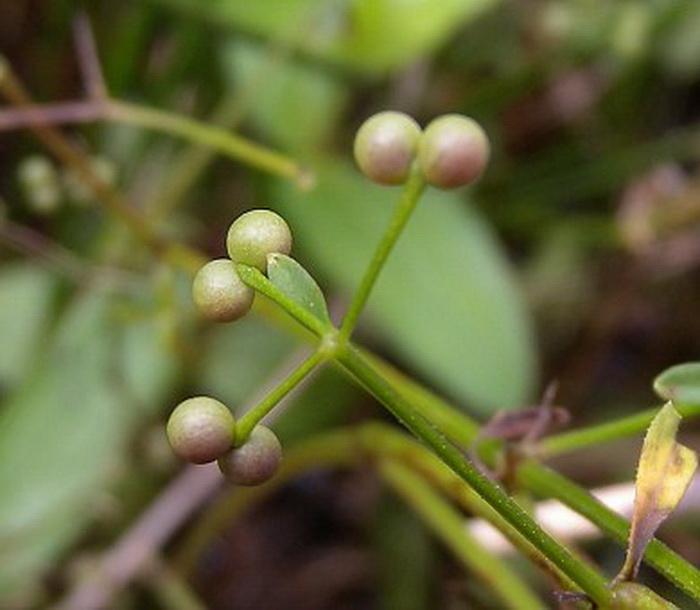
Photographic Location: A wet sand prairie at the Indiana Dunes National Lakeshore in NW Indiana.
Comments: Stiff Bedstraw is unusual because its corollas can have 3-4 lobes on the same plant. In Illinois, the only other bedstraw with 3 lobes on its corollas is Small Bedstraw (Galium trifidum). This latter species is similar to Stiff Bedstraw, but smaller in size and slightly more bristly. In particular, the pedicels of Small Bedstraw are bristly and curved, while those of Stiff Bedstraw are smooth and straight. While Stiff Bedstraw is scattered throughout Illinois, Small Bedstraw is restricted to northern Illinois and a sandy area of central Illinois. This latter species has a more northern distribution and prefers a cool climate.
Both terminal and axillary cymes of 1-3 flowers are produced. Individual flowers are 1/8" (3 mm.) across or a little less; each flower has a white corolla with 3 (less often 4) spreading lobes, a bifurcated two-celled ovary with a pair of styles, and 3 (less often 4) stamens. The surface of the ovary is green and smooth. The pedicels of the flowers or fruits are up to 1" long, straight, and angular; their edges are smooth. The blooming period occurs during the summer for about 2-3 months. Usually, only a few flowers are in bloom at the same time. Each flower is replaced by a two-celled seedpod that is about 1/8" (3 mm.) across. The seedpod changes color as it matures from green, to purple, and black. Each cell of the pod is globoid-ovoid in shape, smooth, and single-seeded. The root system is fibrous and rhizomatous.
Cultivation: The preference is full or partial sun, wet to moist conditions, and soil containing loam, clay-loam, sand, or gravel. Standing water is readily tolerated if it is temporary.

Range & Habitat: The native Stiff Bedstraw is occasional in northern Illinois, and uncommon or absent in the rest of the state (see Distribution Map). Habitats include marshes, fens, low areas along rivers and ponds, swamps, wet sand prairies, prairie swales, and ditches. Stiff Bedstraw is usually found in higher quality wetlands in Illinois.
Faunal Associations: The flowers are cross-pollinated by flies and small bees. The caterpillars of some moths feed on the foliage or flower tissues of Galium spp. These species include: Epirrhoe alternata (White-Bordered Toothed Carpet), Hyles gallii (Galium Sphinx), Lobocleta ossularia (Drab Brown Wave), and Scopula inductata (Soft-Lined Wave). The species Myzus cerasi (Black Cherry Aphid) uses Galium spp. as summer hosts. Three plant bugs in Illinois are known to feed on these plants: Criocoris saliens, Polymerus proximus, and the introduced Polymerus unifasciatus. White-Tailed Deer browse on the foliage sparingly or not at all. Because the bristly hairs of the stems and leaves can cling to passing objects, animals may play a minor role in spreading the seeds to new locations.

Photographic Location: A wet sand prairie at the Indiana Dunes National Lakeshore in NW Indiana.
Comments: Stiff Bedstraw is unusual because its corollas can have 3-4 lobes on the same plant. In Illinois, the only other bedstraw with 3 lobes on its corollas is Small Bedstraw (Galium trifidum). This latter species is similar to Stiff Bedstraw, but smaller in size and slightly more bristly. In particular, the pedicels of Small Bedstraw are bristly and curved, while those of Stiff Bedstraw are smooth and straight. While Stiff Bedstraw is scattered throughout Illinois, Small Bedstraw is restricted to northern Illinois and a sandy area of central Illinois. This latter species has a more northern distribution and prefers a cool climate.
0
0
文章
Miss Chen
2018年06月23日

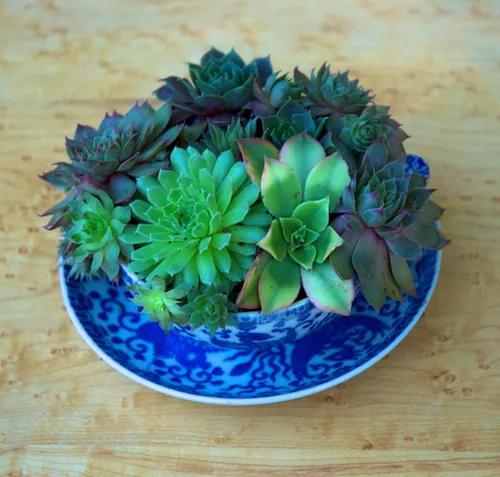
4.Succulent Plants in Tea Cup
Succulents can look great in almost anything - from a very formal container to one that is quite casual. I put these succulent plants in a tea cup that I got at a yard sale. I bought the whole set for a couple of dollars and then drilled holes in the bottoms of the cups.
For succulent plants, good drainage is essential. If you let them sit in water, succulents will quickly rot, so using a fast draining potting mix, and putting holes in your containers is the easiest way to keep your plants healthy.
To drill holes in ceramics, you need a special drill bit and some patience. It takes awhile to get through ceramics, and you have to let the bit cool down so that the heat doesn't build up from the friction and shatter your cup.
Make sure to put your cup on a firm surface. You can place a rag or flat, thin sponge on a counter, or I like to drill outside, on the ground so I don't have to clean up the dust. It's a good idea to wear safety goggles when doing any drilling, but particularly with ceramics which can shatter.
After the holes are drilled, I cut a small piece of plastic window screening and put it over the holes, to keep the soil in and let the water out. You can also use paper towel or a coffee filter.
I then fill the cup, almost to the top, with a cacti and succulent potting mix, plant my succulents and gently water, giving enough moisture so that the soil is damp. I then let the soil in the cup settle and the succulent plants take root.
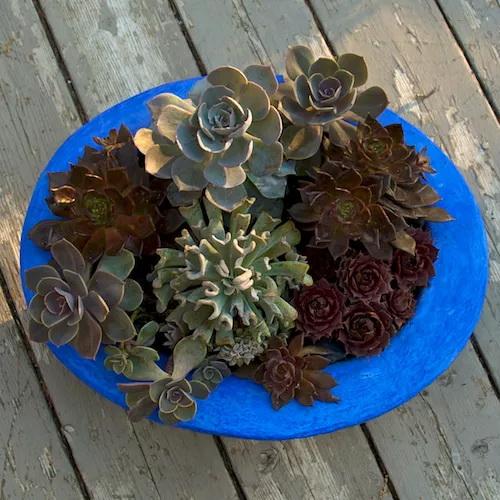
5.Artist's Succulent Pot
What makes this succulent pot work so well is the spectacular concrete vessel, made by California artist, Mary Martha Collins. Mary crafts each pot by hand and then applies one of many stunning colors as a patina. This dish style of pot works particularly well with succulents because it is relatively shallow and succulents have a shallow root system.
When planting succulents, I use a potting mix designed specifically for cactus and succulents, which I buy at a nursery.
I like the strong color of the pot which sets off the interesting colors of the succulent plants.
Because of careless over-watering, when I first planted this pot, some of the original plants died. I simply pulled them out and replaced them with new plants.
Step-by-step instructions for how to make this succulent garden.
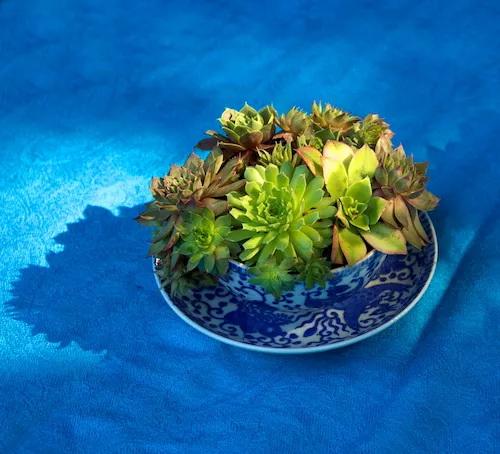
6.Vintage Tea Cup with Mixed Succulent Plants
I love stuffing succulents in small containers. This vintage tea cup and saucer was found at a second hand store and cost a dollar. I used a ceramic bit on a drill to put several holes in the bottom of the cup, to insure the good drainage that succulents need. I then filled the cup with succulent and cactus potting mix and then packed it with a mix of succulents. I water it infrequently - letting the soil dry out between waterings - especially in the winter.
0
0
文章
Miss Chen
2018年06月21日

Description: This perennial plant is 1-4' tall. It is erect and usually remains unbranched. The central stem is light to medium green, terete or angular, and glabrous to sparsely hairy. The alternate leaves are up to 5" long and 2" wide; they are oblanceolate, obovate, ovate, or broadly elliptic in shape, and their margins are serrated. The lower leaves clasp the central stem, while the upper leaves are sessile. The upper surfaces of leaves are medium to dark green and sparingly covered with short hairs. The central stem terminates in a spike-like raceme of flowers about ½-2' long.
The flowers are 1-1½" long, angled upward, and densely distributed along the raceme. Each flower has a blue-violet corolla (rarely white) that is narrowly bell-shaped (campanulate) and 2-lipped. The upper lip has 2 slender erect lobes that curve slightly inward or backward, while the lower lip has 3 descending lobes that are oblong-lanceolate. Near the throat of the flower at the base of the lower lobes, there is a pair of small white patches. The green calyx is deeply divided into 5 linear-lanceolate teeth; it is conspicuously hairy. The calyx teeth are long and spreading. The blooming period occurs from late summer into fall, lasting about 2 months. Afterwards, the flowers are replaced by capsules containing small seeds. These seeds are probably distributed by wind or water to some extent. The root system consists of a central taproot, fromDistribution Map which occasional basal offshoots are produced.
Cultivation: The preference is wet to moist soil and partial sun. Full sun is tolerated if the soil is consistently moist, and light shade is also acceptable. The soil should be fertile and loamy. This plant withstands occasional flooding, but it will become muddy and ragged-looking if it receives too much abuse. The small seeds require light to germinate. Great Blue Lobelia can be highly variable in height, depending on environmental conditions and its stage of development.
Range & Habitat: The native Great Blue Lobelia occurs throughout Illinois, except for a few counties in southern Illinois. It is occasional to locally common. Typical habitats include moist black soil prairies, soggy meadows near rivers, low areas along rivers and ponds, floodplain and bottomland woodlands, woodland borders, bottoms of sandstone canyons along streams, swamps, fens, gravelly seeps and springs, ditches, and moist areas of pastures. Great Blue Lobelia can be found in both disturbed areas and high quality habitats.
Faunal Associations: The nectar and pollen of the flowers attract primarily bumblebees and other long-tongued bees (Anthophora spp., Melissodes spp., Svastra spp.). Less common visitors include the Ruby-Throated Hummingbird, large butterflies, and Halictid bees. The Halictid bees collect pollen only and they are non-pollinating. The caterpillars of a moth, Enigmogramma basigera (Pink-washed Looper Moth), feed on the foliage of Great Blue Lobelia (Schweitzer & Roberts, 2007). Most mammalian herbivores don't eat this plant because the foliage contains several toxic alkaloids, chief among them being lobeline and lobelanine. These toxic substances produce symptoms that resemble nicotine poisoning. However, it has been reported that deer occasionally eat this plant, perhaps enjoying greater immunity to these toxic substances than other animals. The seeds are too small to be of much value to birds.
Photographic Location: The photographs were taken at a garden of the Anita Purves Nature Center in Urbana, Illinois.

Comments: Great Blue Lobelia is a lovely plant that produces some welcome diversity with its violet-blue flowers during late summer or fall, when forbs with yellow flowers are typically dominant. Unfortunately, its value to wildlife is rather limited. Among the Lobelia spp. with bluish flowers in Illinois, Great Blue Lobelia has the largest flowers and they are usually a more deep shade of blue-violet, making it easy to identify.
The flowers are 1-1½" long, angled upward, and densely distributed along the raceme. Each flower has a blue-violet corolla (rarely white) that is narrowly bell-shaped (campanulate) and 2-lipped. The upper lip has 2 slender erect lobes that curve slightly inward or backward, while the lower lip has 3 descending lobes that are oblong-lanceolate. Near the throat of the flower at the base of the lower lobes, there is a pair of small white patches. The green calyx is deeply divided into 5 linear-lanceolate teeth; it is conspicuously hairy. The calyx teeth are long and spreading. The blooming period occurs from late summer into fall, lasting about 2 months. Afterwards, the flowers are replaced by capsules containing small seeds. These seeds are probably distributed by wind or water to some extent. The root system consists of a central taproot, fromDistribution Map which occasional basal offshoots are produced.
Cultivation: The preference is wet to moist soil and partial sun. Full sun is tolerated if the soil is consistently moist, and light shade is also acceptable. The soil should be fertile and loamy. This plant withstands occasional flooding, but it will become muddy and ragged-looking if it receives too much abuse. The small seeds require light to germinate. Great Blue Lobelia can be highly variable in height, depending on environmental conditions and its stage of development.
Range & Habitat: The native Great Blue Lobelia occurs throughout Illinois, except for a few counties in southern Illinois. It is occasional to locally common. Typical habitats include moist black soil prairies, soggy meadows near rivers, low areas along rivers and ponds, floodplain and bottomland woodlands, woodland borders, bottoms of sandstone canyons along streams, swamps, fens, gravelly seeps and springs, ditches, and moist areas of pastures. Great Blue Lobelia can be found in both disturbed areas and high quality habitats.
Faunal Associations: The nectar and pollen of the flowers attract primarily bumblebees and other long-tongued bees (Anthophora spp., Melissodes spp., Svastra spp.). Less common visitors include the Ruby-Throated Hummingbird, large butterflies, and Halictid bees. The Halictid bees collect pollen only and they are non-pollinating. The caterpillars of a moth, Enigmogramma basigera (Pink-washed Looper Moth), feed on the foliage of Great Blue Lobelia (Schweitzer & Roberts, 2007). Most mammalian herbivores don't eat this plant because the foliage contains several toxic alkaloids, chief among them being lobeline and lobelanine. These toxic substances produce symptoms that resemble nicotine poisoning. However, it has been reported that deer occasionally eat this plant, perhaps enjoying greater immunity to these toxic substances than other animals. The seeds are too small to be of much value to birds.
Photographic Location: The photographs were taken at a garden of the Anita Purves Nature Center in Urbana, Illinois.

Comments: Great Blue Lobelia is a lovely plant that produces some welcome diversity with its violet-blue flowers during late summer or fall, when forbs with yellow flowers are typically dominant. Unfortunately, its value to wildlife is rather limited. Among the Lobelia spp. with bluish flowers in Illinois, Great Blue Lobelia has the largest flowers and they are usually a more deep shade of blue-violet, making it easy to identify.
0
0
文章
Miss Chen
2018年06月18日

Description: This herbaceous perennial plant is 1-4' tall, branching occasionally. The stems are square or round, and usually pubescent where new growth occurs, becoming glabrous with age. The hairless leaves are opposite or alternate along the stems, sessile or with short petioles, and up to 4" long and ½" across. They are narrowly lanceolate in shape, and sometimes have purple veins or spots. There are 4-8 teeth per centimeter along the margin of each leaf.
From the upper axils of some of the upper leaves, there appears a single flower with a long calyx tube on a short stalk (peduncle). This calyx tube is pubescent and more or less erect, terminating in 4 lanceolate sepals that often tinted purple or pink. These sepals are a little shorter than the petals. The 4 notched petals are white or light pink, and span about 1/3" across. At the throat of the flower, there is a prominent pistil that is often knobby at the end, which is surrounded by several stamens. These flowers bloom for about a month during late summer or early fall. The calyx tube matures into an elongated seed capsule, which splits open to release a multitude of tiny seeds with small tufts of reddish brown hair. These seeds are distributed by the wind. The root system is fibrous and produces rhizomes, which enables this plant to spread vegetatively.
Cultivation: The preference is full sun to light shade, and wet to moist conditions. The soil should contain lots of organic material to retain moisture. The foliage is rather fragile and can become damaged easily. This plant tolerates occasional flooding, and prefers rather cool conditions.
Range & Habitat: The native Cinnamon Willow-Herb occurs occasionally in northern and central Illinois, but it is uncommon or absent in the southern section of the state. Its range extends further to the south than other Epilobium spp., which are usually restricted to northern Illinois. Habitats include poorly drained areas of black soil prairies, moist woodlands, woodland borders, and various kinds of wetlands, including marshes, bogs, fens, seeps, and edges of ponds, rivers, or drainage ditches. The Willow Herbs are pioneer species that thrive on some kind of disturbance, such as fire.
Faunal Associations: The flowers probably attract bees and flower flies, which seek nectar and pollen. The caterpillars of various moths eat the foliage of Willow-Herbs, including Hyles lineata (White-Lined Sphinx), Eudryas unio (Pearly Wood Nymph), Anticlea multiferata (Many-Lined Carpet), and Scythris magnabella (Scythridid Moth sp.). The seeds are too small to be of much interest to birds. The foliage is non-toxic and occasionally eaten by mammalian herbivores, but it has low food value.
Photographic Location: A poorly drained area of prairie in Meadowbrook Park, Urbana, Illinois.
Comments: The flowers are rather small-sized, but they are often produced in abundance on large plants. The most distinctive characteristic of Cinnamon Willow-Herb is the reddish brown coloration of the tufts of hair on the seeds, which is responsible for the common name of this plant. Other Epilobium spp. have tufts of hair that are white or faded brown or grey. Cinnamon Willow-Herb also has serrated leaves with 4-8 teeth per centimeter, while other Willow-Herbs have leaves with either smooth edges or fewer teeth per centimeter. An unusual characteristic of the Willow-Herbs is the long calyx-tube of the flowers, which occurs behind the petals, and eventually becomes an elongated seed capsule. It looks like a flowering stalk (peduncle), but it is actually part of the flower where the ovaries are contained. In some members of the Mustard family and miscellaneous other plants, an elongated seed capsule develops in front of the petals. This is one way to determine whether the plant in front of you is a Willow-Herb, or a quite different species of plant.
From the upper axils of some of the upper leaves, there appears a single flower with a long calyx tube on a short stalk (peduncle). This calyx tube is pubescent and more or less erect, terminating in 4 lanceolate sepals that often tinted purple or pink. These sepals are a little shorter than the petals. The 4 notched petals are white or light pink, and span about 1/3" across. At the throat of the flower, there is a prominent pistil that is often knobby at the end, which is surrounded by several stamens. These flowers bloom for about a month during late summer or early fall. The calyx tube matures into an elongated seed capsule, which splits open to release a multitude of tiny seeds with small tufts of reddish brown hair. These seeds are distributed by the wind. The root system is fibrous and produces rhizomes, which enables this plant to spread vegetatively.
Cultivation: The preference is full sun to light shade, and wet to moist conditions. The soil should contain lots of organic material to retain moisture. The foliage is rather fragile and can become damaged easily. This plant tolerates occasional flooding, and prefers rather cool conditions.
Range & Habitat: The native Cinnamon Willow-Herb occurs occasionally in northern and central Illinois, but it is uncommon or absent in the southern section of the state. Its range extends further to the south than other Epilobium spp., which are usually restricted to northern Illinois. Habitats include poorly drained areas of black soil prairies, moist woodlands, woodland borders, and various kinds of wetlands, including marshes, bogs, fens, seeps, and edges of ponds, rivers, or drainage ditches. The Willow Herbs are pioneer species that thrive on some kind of disturbance, such as fire.
Faunal Associations: The flowers probably attract bees and flower flies, which seek nectar and pollen. The caterpillars of various moths eat the foliage of Willow-Herbs, including Hyles lineata (White-Lined Sphinx), Eudryas unio (Pearly Wood Nymph), Anticlea multiferata (Many-Lined Carpet), and Scythris magnabella (Scythridid Moth sp.). The seeds are too small to be of much interest to birds. The foliage is non-toxic and occasionally eaten by mammalian herbivores, but it has low food value.
Photographic Location: A poorly drained area of prairie in Meadowbrook Park, Urbana, Illinois.
Comments: The flowers are rather small-sized, but they are often produced in abundance on large plants. The most distinctive characteristic of Cinnamon Willow-Herb is the reddish brown coloration of the tufts of hair on the seeds, which is responsible for the common name of this plant. Other Epilobium spp. have tufts of hair that are white or faded brown or grey. Cinnamon Willow-Herb also has serrated leaves with 4-8 teeth per centimeter, while other Willow-Herbs have leaves with either smooth edges or fewer teeth per centimeter. An unusual characteristic of the Willow-Herbs is the long calyx-tube of the flowers, which occurs behind the petals, and eventually becomes an elongated seed capsule. It looks like a flowering stalk (peduncle), but it is actually part of the flower where the ovaries are contained. In some members of the Mustard family and miscellaneous other plants, an elongated seed capsule develops in front of the petals. This is one way to determine whether the plant in front of you is a Willow-Herb, or a quite different species of plant.
0
0
文章
Miss Chen
2018年06月16日

Description: This herbaceous perennial plant forms a small tuft of ascending to arching basal leaves about 4-12" (10-30 cm.) long. Individual basal leaves are about 1 mm. across, medium green, terete, and hairless (or nearly so). One or two erect floral stalks about 8-16" (20-40 cm.) long develop from the tuft of leaves; these stalks are about 1.5 mm. across, reddish brown, terete, and hairless. The foliage is reportedly aromatic when crushed. Each stalk has a narrow raceme of flowers about 3-10" (7.5-25 cm.) long; these flowers alternate along the stalk and they are sparsely distributed. Each flower is about 2 mm. across, consisting of 3 purplish green petals, 3 purplish green sepals, 3 fertile green pistils that are joined together, and 6 inconspicuous stamens. The outer sepals are orbicular-ovate in shape, while the inner petals have a flattened-pyriform shape. The stigmas of the pistils are white and feathery (plumose).
The slender pedicels of the flowers are 2-10 mm. long, ascending to erect, reddish brown, and hairless. The blooming period occurs during the summer and early autumn, lasting about 1-2 months for a large colony of plants. The flowers are cross-pollinated by the wind. Afterwards, the pistils develop into 3-celled fruits (schizocarps) about 7-9 mm. long and 1 mm. across. These fruits are narrowly oblongoid-oblanceoloid in shape and 3-angled; they are initially green, but later become brown. At maturity, these fruits divide longitudinally into 3 narrow sections, beginning at the bottom. The central axis of each fruit is 3-winged; there are 3 seeds per fruit. The seeds are similar in appearance to their fruits, but a little shorter and more slender. The root system consists of a whitish crown with fibrous roots.

Cultivation: The preference is full sun, wet conditions, and a barren calcareous soil containing an abundance of sand or gravel. This plant is intolerant of competition from other ground vegetation. It is quite cold-hardy.
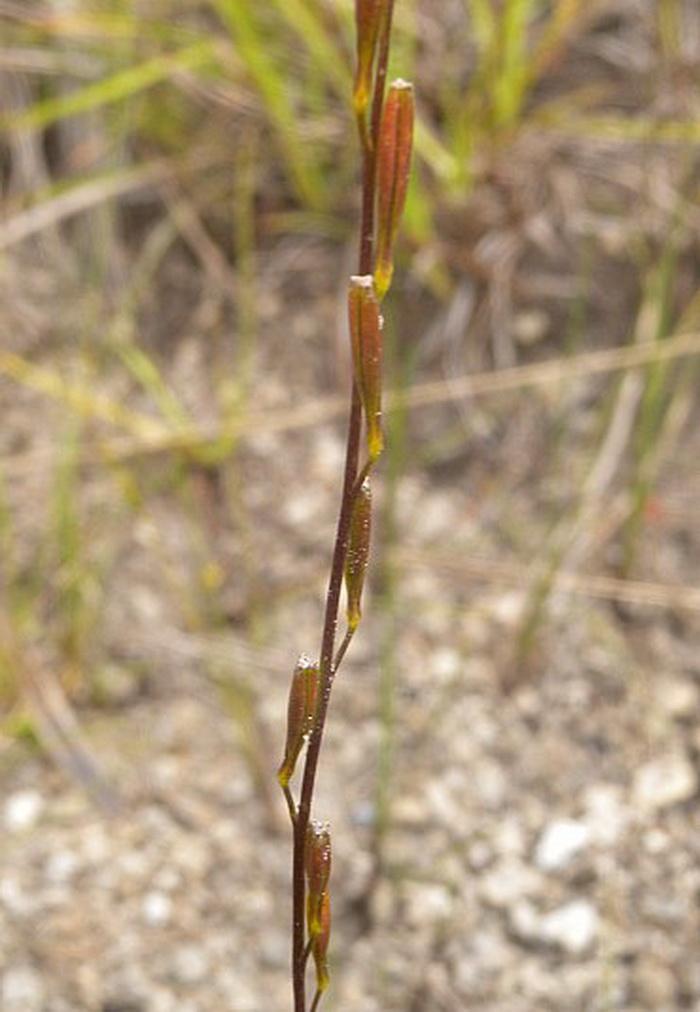
Range & Habitat: The native Slender Arrowgrass (Triglochin palustris) is rare in Illinois, where it is state-listed as 'endangered.' It is found in the NE section of the state and 2 counties toward the center of the state (see Distribution Map). Illinois lies along the southern range-limit of this species. In the United States, Slender Arrowgrass occurs in the New England region, Great Lakes area, Northern Plains, and scattered areas of the western states. It also occurs in Canada, Eurasia, and New Zealand. In Illinois, habitats consist primarily of fens, calcareous gravelly seeps, marl flats, and calcareous sandy pannes near Lake Michigan. This very conservative plant is restricted to high quality natural areas within the state.

Faunal Associations: Floral-faunal relationships of this plant in Illinois are not known. Further to the north in Canada and Alaska, the foliage and especially the whitish crowns are a preferred source of food for the adults and goslings of several species of geese, including Branta canadensis (Canada Goose), Branta bernicula nigricans (Black Brant Goose), and Chen caerulescens (Lesser Snow Goose). The foliage and crowns of Slender Arrowgrass (Triglochin palustris) are reportedly high in protein and low in fiber (Mulder et al., 1996; Prevett et al., 1985).

The foliage also contains hydrocyanic compounds that can be toxic to sheep and cattle if it is consumed in sufficient quantity. There is some evidence in Europe that the seeds of this plant can cling to the fur of deer and cattle. Thus, these animals can spread the seeds to new areas (Mouissie et al., 2005).
Photographic Location: A gravelly seep in McHenry County, Illinois.
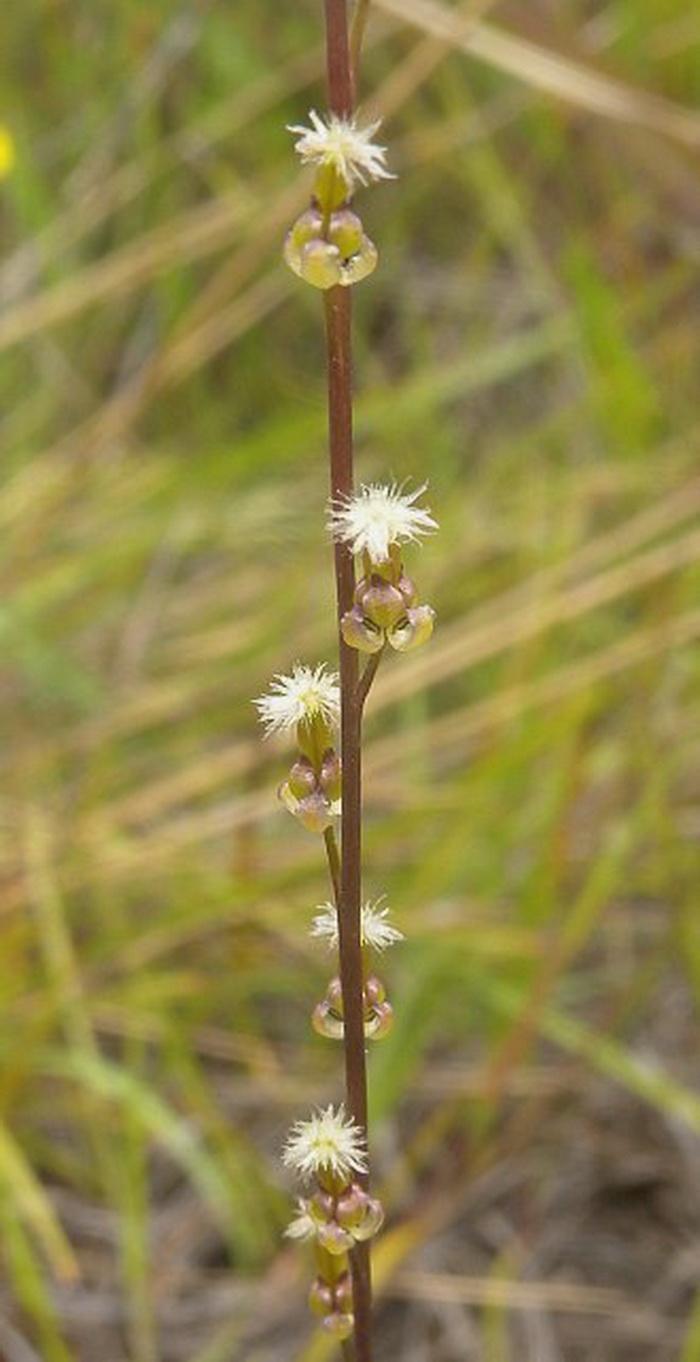
Comments: This plant is not very showy and it is easily overlooked. The only other species of this genus that occurs in Illinois, Sea Arrowgrass (Triglochin maritima), is also very rare within the state and it occurs in similar areas. Sea Arrowgrass is a little larger and stouter than Slender Arrowgrass (Triglochin palustris) overall. Its fruits (schizocarps) have a wider ovoid shape and they divide into 6 sections (6 seeds per fruit), rather than 3 sections. Unlike Slender Arrowgrass, the central axis of its fruit is not winged. The wind-pollinated flowers of these plants are rather odd-looking because their feathery stigmas resemble tufts of hair that are typically found on seeds. An alternative spelling of the scientific name for Slender Arrowgrass is Triglochin palustre, and another common name of this plant is Marsh Arrowgrass.
The slender pedicels of the flowers are 2-10 mm. long, ascending to erect, reddish brown, and hairless. The blooming period occurs during the summer and early autumn, lasting about 1-2 months for a large colony of plants. The flowers are cross-pollinated by the wind. Afterwards, the pistils develop into 3-celled fruits (schizocarps) about 7-9 mm. long and 1 mm. across. These fruits are narrowly oblongoid-oblanceoloid in shape and 3-angled; they are initially green, but later become brown. At maturity, these fruits divide longitudinally into 3 narrow sections, beginning at the bottom. The central axis of each fruit is 3-winged; there are 3 seeds per fruit. The seeds are similar in appearance to their fruits, but a little shorter and more slender. The root system consists of a whitish crown with fibrous roots.

Cultivation: The preference is full sun, wet conditions, and a barren calcareous soil containing an abundance of sand or gravel. This plant is intolerant of competition from other ground vegetation. It is quite cold-hardy.

Range & Habitat: The native Slender Arrowgrass (Triglochin palustris) is rare in Illinois, where it is state-listed as 'endangered.' It is found in the NE section of the state and 2 counties toward the center of the state (see Distribution Map). Illinois lies along the southern range-limit of this species. In the United States, Slender Arrowgrass occurs in the New England region, Great Lakes area, Northern Plains, and scattered areas of the western states. It also occurs in Canada, Eurasia, and New Zealand. In Illinois, habitats consist primarily of fens, calcareous gravelly seeps, marl flats, and calcareous sandy pannes near Lake Michigan. This very conservative plant is restricted to high quality natural areas within the state.

Faunal Associations: Floral-faunal relationships of this plant in Illinois are not known. Further to the north in Canada and Alaska, the foliage and especially the whitish crowns are a preferred source of food for the adults and goslings of several species of geese, including Branta canadensis (Canada Goose), Branta bernicula nigricans (Black Brant Goose), and Chen caerulescens (Lesser Snow Goose). The foliage and crowns of Slender Arrowgrass (Triglochin palustris) are reportedly high in protein and low in fiber (Mulder et al., 1996; Prevett et al., 1985).

The foliage also contains hydrocyanic compounds that can be toxic to sheep and cattle if it is consumed in sufficient quantity. There is some evidence in Europe that the seeds of this plant can cling to the fur of deer and cattle. Thus, these animals can spread the seeds to new areas (Mouissie et al., 2005).
Photographic Location: A gravelly seep in McHenry County, Illinois.

Comments: This plant is not very showy and it is easily overlooked. The only other species of this genus that occurs in Illinois, Sea Arrowgrass (Triglochin maritima), is also very rare within the state and it occurs in similar areas. Sea Arrowgrass is a little larger and stouter than Slender Arrowgrass (Triglochin palustris) overall. Its fruits (schizocarps) have a wider ovoid shape and they divide into 6 sections (6 seeds per fruit), rather than 3 sections. Unlike Slender Arrowgrass, the central axis of its fruit is not winged. The wind-pollinated flowers of these plants are rather odd-looking because their feathery stigmas resemble tufts of hair that are typically found on seeds. An alternative spelling of the scientific name for Slender Arrowgrass is Triglochin palustre, and another common name of this plant is Marsh Arrowgrass.
0
0




